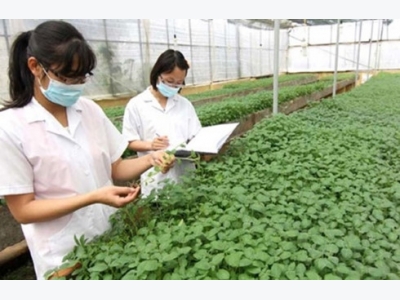Can Japan agri-tech cultivate a new crop of farmers in Vietnam?

Nowadays the press is filled with an abundance of stories about high-tech investment of Japanese concerns into Vietnam agriculture and how it might revitalize the sector for economic growth, job creation and food security.
To get a handle on the forces prompting the Japanese investment, it is important to keep in mind that the East Asian Pacific Island nation has a shrinking farmer population and farmland hectarage.
According to official Japanese government statistics, the number of full-time farmers in the decade leading up to 2014 (the latest year for which figures are available) dropped by a half million from 2.2 to 1.7 million in 2014.
Not only is the country suffering from a decline in the agriculture workforce as older farmers retire and younger workers opt for careers in other fields, the hectarage under cultivation has steadily declined as well.
In 2015 alone, some 420,000 hectares of fertile farmland were taken out of production, according to Japanese government data.
These key points are essential to coming to grips with why Japanese farmers are turning to technological solutions or ‘agri-tech’ to meet the country’s demands for high quality food products.
Agri-tech has the distinct advantages of generally increasing productivity; lowering costs; using less energy, water, pesticides and other resources; all while improving product quality and availability.
These factors also explain the avid interest of Japanese in investing in agri-tech agriculture in Southeast Asia in general and Vietnam specifically as they see big opportunities down the road to cash in on exports back to their home country.
Business analysts forecast the Japanese food market for imports is primed for extensive growth over the decades ahead. As domestic production dwindles, food needs would require a doubling of agriculture imports, say many of these experts.
The Japanese demographics are also tipped in favour of more food imports, whereby according to UN figures, in developed countries the average age of the populace is 60, in Japan it has already risen to 67 and still inching upwards.
As physical activities bring more difficulties for a greater number of aging Japanese farmers, technological innovations to assist with and replace workers performing agricultural tasks is an urgent priority.
But it isn’t just a quest for earnings in food production as big corporations the likes of Mitsubishi, Fujitsu, and Panasonic see gold in investing heavily in agricultural technology for its own earnings in both domestic and global markets.
Tractica, a market intelligence firm, forecasts the global market for agricultural robots to reach US$73.9 billion by 2024, up from US$3 billion in 2015. Driverless tractors are expected to garner revenue of US$30.7 billion by 2024, with agricultural drones expected to be in exceptionally high demand.
Agri-tech farm applications are wide ranging. Conceivably, a typical futuristic farm scenario could involve a driverless tractor in a rice paddy field utilizing a global positioning system, both synchronized to automate cultivation and fertilization after monitoring the soil conditions.
Japanese automated greenhouses and vertical farms get the most coverage in the news media but there is so much more to agri-tech including such things as robotic automation, the use of IT systems and sensors to measure and control growing processes, evidently enhancing work efficiencies, crop yields and produce quality.
The valuable experience and techniques of veteran farmers such as learning about harvesting times with databases and photos is another added benefit of Japanese investment in Vietnam agriculture.
One thing, that all the experts agree on is the proposition that Vietnamese agriculture will never make the transition to agri-tech on its own.
The only real question is whether Vietnamese farmers can work alongside tech-savvy, older, more experienced and sophisticated Japanese farmers, and learn how to overcome the plethora of challenges the sector currently faces.
Related news
 Prime Minister requests to enhance the rice exports
Prime Minister requests to enhance the rice exports The Prime Minister assigns ministries and sectors under their assigned functions and tasks to synchronously implement solutions to enhance the rice exports
 Japan leads agriculture trade mission to Vietnam
Japan leads agriculture trade mission to Vietnam A contingent of representatives from Japan held trade talks with members of the Ha Nam Province People’s Committee on April 26 focused on promoting
 Local business imports nearly 1,800 Australian cows
Local business imports nearly 1,800 Australian cows A business in the Mekong Delta province of Can Tho has imported 1,768 cows from Australia to supply beef at competitive prices to HCM City